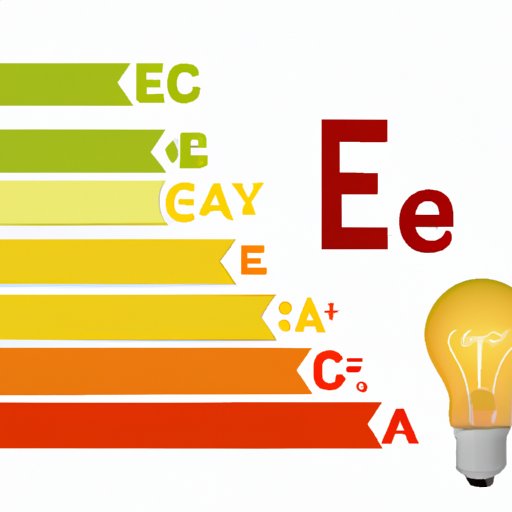Introduction
Understanding your home’s energy consumption is critical for maintaining its ecological sustainability and reducing your electricity bill. A home’s energy usage is measured in kilowatt-hours (kWh), and it is essential to understand what that means and how to calculate it. In this article, we will discuss how to measure your home’s kWh usage and the average energy consumption of a typical home. Additionally, we will provide tips for reducing kWh usage and finding energy waste in your home.
Understanding Energy Consumption: A Guide to Calculating Your Home’s kWh Usage
Kilowatt-hours (kWh) is a unit of measurement for energy consumption, and it is used to calculate your electricity bill. It is the amount of energy used by a device multiplied by the number of hours it was active, usually measured over a month. If you have access to your billing details, you can find your monthly kWh usage on your electricity bill. If you do not have the bill, you can find the usage from your house’s electrical meter; it will display the number of kWh used during the billing period.
To determine your home’s energy consumption, you can follow these simple steps:
- Record your current and previous meter readings for the billing period.
- Subtract the previous reading from the current reading to get the total kilowatt-hours used.
- Divide the kWh usage by the total number of days in the billing period to determine the average daily usage.
The Costs of Energy Consumption: A Breakdown of kWh Usage for the Average Home
An average home consumes about 900 kWh/month, with heating and cooling systems making up the most significant portion of that consumption. A furnace consumes between 600 and 1500 watts, while an air conditioner uses up to 1500 watts. The refrigerator and freezer account for about 5-25% of the home’s energy usage, while lighting consumes 5-10%. The remaining energy usage is divided among other appliances in the house, like washing machines, dishwashers, and electronics.
Typically, a household’s electricity consumption in kWh is crucial in determining the electric bill you will pay. The average electricity cost in the United States is 12 cents per kilowatt-hour, but prices can vary depending on the state and the provider.
Going Green: How to Cut Your kWh Usage and Save Money on Your Electricity Bill
Reducing your energy usage and saving money on your electricity bill is simple, and here are some tips:
- Replace incandescent light bulbs with energy-saving LED bulbs, which use 75% less electricity.
- Unplug electronics when they are not in use, or use a smart power strip to reduce vampire power consumption.
- Seal air leaks around your house to prevent drafts from coming in, which improves insulation and reduces heating or cooling loads.
- Install energy-efficient windows and doors to reduce heat transfer between inside and outside the house.
- Perform routine maintenance on HVAC systems to ensure their optimal performance and to save energy consumption.
Another way to reduce your energy consumption is to choose appliances that are energy efficient, marked with the Energy Star label, which means that they meet specific energy-efficiency requirements. Appliances with this label consume 10-50% less energy than conventional models.
Professional advice is necessary when going green. Seek advice from your local energy company or hire a certified home-energy auditor to assess your home’s energy consumption in detail. You can also visit the Department of Energy’s website for more information on different energy-efficient options.
Comparing kWh Usage: How Different Appliances Impact Your Home’s Energy Consumption
Here are some of the common appliances and their corresponding energy consumption:
- Refrigerator: 50-200 kWh/year
- Dishwasher: 1.4 kWh/cycle
- Clothes washer: 0.3 to 1.5 kWh/cycle
- Clothes dryer: 1.5 to 4 kWh/load
- Electric oven/cooktop: 2 to 5 kWh/hour of use
You can choose appliances with high energy efficiency to lower your energy consumption and reduce the cost of your energy bill.
The Surprising Ways Your Home Is Wasting Energy: Tips for Lowering Your kWh Usage
Here are some unexpected ways that your home may be wasting energy:
- Unused electronics and chargers plugged in but not in use account for 5% of the average home’s energy consumption annually.
- Drafty windows and broken seals let cold air in and hot air out, increasing heating and cooling expenses.
- Leaky faucets and pipes can waste up to 90 gallons of water a day, which costs both energy and money to heat the water.
- Energy inefficient laundry appliances can add up to 10% of your energy bill.
By regularly checking for energy waste and making simple changes, you can lower your energy consumption, save money, and contribute to a more ecologically sustainable world.
Conclusion
Understanding your home’s kWh usage is essential for reducing energy waste, saving money on your electricity bill, and contributing to a more sustainable world. Consider implementing the tips outlined in this article to reduce your energy consumption and lower your monthly bills. For further guidance, consider consulting an energy company expert or a certified home-energy auditor.
